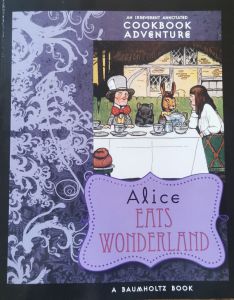“The rule is, jam tomorrow and jam yesterday – but never jam today!”
Er zijn naar aanleiding van de twee ‘Alice-boeken’ ontelbaar veel artikelen en boeken verschenen om de teksten te duiden. Die gaan in alle richtingen: historisch, cultureel, sociologisch, psychologisch en taalkundig als ook culinair. Al die categorieën kun je ook weer onderling koppelen, waardoor er interessante inzichten en conclusies ontstaan. Een mooi voorbeeld is het artikel “How little girls are like serpents, or, food and power in Lewis Carroll’s Alice books” van Katja Jylkka. Het werd gepubliceerd in The Carrollian, het magazine van The Lewis Carroll Society. Het is hoogst interessant en is integraal terug te lezen op de site Alice-in-Wonderland.net
Ik ben geen historicus maar een boekenverzamelaar van zowel Lewis Carroll als van kookboeken in het algemeen en daardoor heb ik ook een aantal op de Alice-boeken geïnspireerde uitgaven. Dat die boeken zijn verschenen is niet zo onverwacht, beide verhalen van Alice zijn doorspekt met eten en de interactie daarmee, zoals met de sinaasappel marmelade, het ‘drink me’ drankje en ‘eet me’ koekje, de paddenstoel van de rups, de eieren van de duif, de pepersoep, de kat die uit Cheddar komt, de stroopput, natuurlijk de theevisite bij de Maartse Haas, flamingo’s en mosterd, de witvis en de slak, de soepschildpad, de kreeft en de jamgebakjes. En dan heb ik nog niet eens alles opgenoemd uit ‘Alice in Wonderland’ om nog maar te zwijgen van ‘Achter de spiegel en wat Alice daar aantrof’. Tijd om mijn kleine verzameling Alice-kookboeken eens even op een rijtje te zetten.
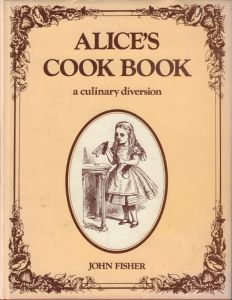

Alice’s Cook Book van John Fisher is denk ik wel de meest bekende uitgave. Helaas heb ik (nog) geen Engelse editie in mijn bezit, maar wel de Nederlandse vertaling ‘Het kookboek van Alice in Wonderland’, die een jaar na de oorspronkelijke uitgave verscheen. In het boek zijn fragmenten van de originele vertaalde tekst opgenomen (van Reedijk en Kossmann), afgewisseld met de illustraties van Tenniel en deze volgen de Alice-boeken getrouw. Het is dan ook niet meer dan logisch dat het eerste recept in het boek sinaasappeljam betreft, ook al is de pot die Alice pakt leeg. Dit is de enige Nederlandstalige uitgave die ik heb, de recepten werden vertaald door Lenie Schenk.
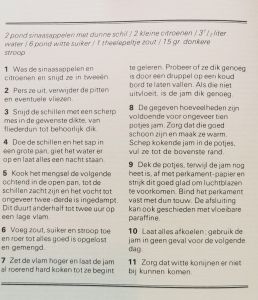
Wat ook aardig is dat achter in het boek de etiquette regels van Lewis Carroll zijn opgenomen die hij voor het eerst publiceerde in ‘The Comic Times’ op 13 0oktober 1855, dus tien jaar voor de publicatie van ‘Alice’s Adventures in Wonderland.’ Het werd later opgenomen in ‘Mishmash’, een door hem uitgegeven tijdschriftje tot ‘stichting en vermaak’ van zijn familie. Deze plaats ik hier ook integraal, maar dan in de originele taal.
Hints for Etiquette: Or, Dining Out Made Easy:
As caterers for the public taste, we can conscientiously recommend this book to all diners-out who are perfectly unacquainted with the usages of society. However we may regret that our author has confined himself to warning rather than advice, we are bound in justice to say that nothing here stated will be found to contradict the habits of the best circles. The following examples exhibit a depth of penetration and a fullness of experience rarely met with:
I
In proceeding to the dining-room, the gentleman gives one arm to the lady he escorts– it is unusual to offer both.
II
The practice of taking soup with the next gentleman but one is now wisely discontinued; but the custom of asking your host his opinion of the weather immediately on the removal of the first course still prevails.
III
To use a fork with your soup, intimating at the same time to your hostess that you are reserving the spoon for beefsteaks, is a practice wholly exploded.
IV
On meat being placed before you, there is no possible objection to your eating it, if so disposed; still in all such delicate cases, be guided entirely by the conduct of those around you.
V
It is always allowable to ask for artichoke jelly with your boiled venison; however there are houses where this is not supplied.
VI
The method of helping roast turkey with two carving-forks is practicable, but deficient in grace.
VII
We do not recommend the practice of eating cheese with a knife and fork in one hand, and a spoon and wine-glass in the other; there is a kind of awkwardness in the action which no amount of practice can entirely dispel.
VII
As a general rule, do not kick the shins of the opposite gentleman under the table, if personally unacquainted with him; your pleasantry is liable to be misunderstood — a circumstance at all times unpleasant.
IX
Proposing the health of the boy in buttons immediately on the removal of the cloth is custom springing from regard to his tender years, rather than from a strict adherence to the rules of etiquette.
De tweede uitgave is getiteld Alice Eats Wonderland. “An irreverent annotated cookbook adventure in which a gluttonous Alice devours many of the Wonderland characters.” Auteurs zijn August A. Imholtz Jr. en Alison Tannenbaum en de illustraties zijn van A.E.K. Carr. Sommige stukken hebben in de Bandersnatch gestaan. Het is een bijzonder interessant boekje, omdat het veel vertelt over de historische context van de recepten en de te gebruiken ingrediënten. De uitgave die ik heb lijkt een soort van kopie gezien de kwaliteit van sommige afbeeldingen. Ook dit boek begint met sinaasappels, maar daarbij wordt uitgelegd welke soort sinaasappels naar alle waarschijnlijkheid werden (of zouden moeten worden) gebruikt en doet vervolgens suggesties voor twee soorten marmelade. In kaders staan fragmenten uit de Alice-boeken.
De toelichtingen zijn interessant en het commentaar is humoristisch. Enkele commentaren in der pers:
“What we’ve always needed… Couldn’t be worse”.
“Simply awful”
“Several foul, fowl dishes for the Holiday Season”
Waarop de auteurs de volgende suggesties doen:
“Remove any plastic packaging from the book, place it on a non-stick cookie-sheet, and bake it at 250 F for 35 minutes. Test for doneness with a steel skewer. Slice thinly, perpendicular to the binding, and, for a special treat, serve with Marmite or Orange Marmelade (recipe given in Chapter 1), or both.”
De toon is gezet! Ondanks alle gekkigheid een leerzaam en interessant boekje.
Dan twee printing on demand boekjes, super saai, maar wel met normale recepten .
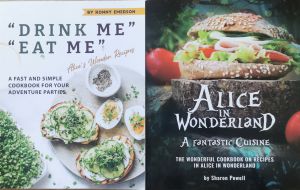
“DRINK ME” “EAT ME” van Ronny Emerson. Geen verwijzingen naar eet-situaties uit de Alice-boeken, behalve op de cover (“Alice’s Wonder Recipes”) en in de inleiding, waarin de auteur vertelt dat hij de Alice-boeken vaak heeft gelezen. Er zijn nog vier uitgaven van deze auteur met het thema ‘Alice’ en nog dertig of meer andere titels gebaseerd op andere klassieke literaire werken.
Alice in Wonderland, A Fantastic Cuisine van Sharon Powell . Alle recepten verwijzen naar figuren of situaties in de Alice-boeken, gemakkelijk te maken recepten, jammer genoeg een hele saaie lay-out met nog saaiere zwartwit foto’s.
Vervolgens twee leuke boeken om een party te organiseren.
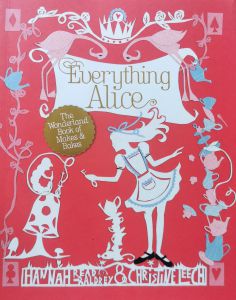
Everything Alice, the Wonderland Book of Makes & Bakes van Hannah Read-Baldrey & Christine Leech. Rijk geïllustreerd met allerlei tips en trucs om een echte Alice in Wonderland party aan te kleden, werkinstructies voor onder andere een Mad Hatter cupcake box, Mad Hatter Hats, Fabric Covered teapots, Teacup Candles, Giant Rose Lights en Crown Place Cards. En met hier en daar ook nog lekkere recepten, zoals Duchess Macaroons en Red Velvet Cupcakes. Voor in het boek een uitleg over de Alice-boeken en Lewis Carroll met twee illustraties van Tenniel.
Create your own Alice & the Mad Hatters Tea Party van MacMillan, geen auteursvermelding. “Games, dressing-up, party food and crafts, with over 200 stickers” Het boek beperkt zich tot het hoofdstuk ‘A Mad Tea Party’. Delen van de tekst staan verspreid door het boek en er staan veel Tenniel-illustraties in. Mooie uitgave en een prima handleiding voor een geslaagde theevisite!
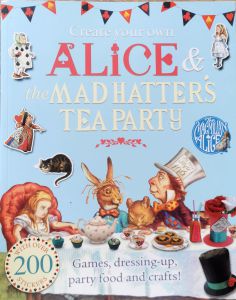
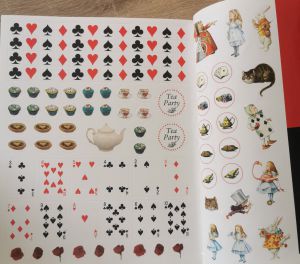
Dan het kloeke werk Alice Eats, a Wonderland Cookbook van Pierre A. Lamielle en Julie van Roosendaal. De gehele tekst van Alice’s Adventures in Wonderland staat in het boek en en het is zeer fraai geïllustreerd. Leuke recepten zoals Prize-winning comfits, Curled-Up Treacle Scones, Alice’s Little Bacon-and-Egg Salad sandwiches en The Queen of Hearts Jam Tarts, waarvan hieronder het recept. Dit is een echte aanrader, ook omdat het zo prachtig geïllustreerd is.

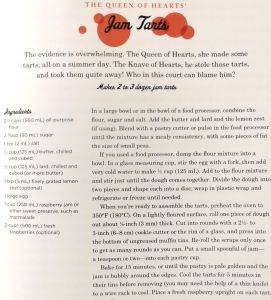
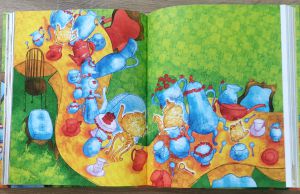
Nog drie te gaan, allereerst Wonderland Reloaded, A Revolution in Your Fridge van Buffy Naillon, The Wonderland Café. Het is een parodie op “The Matrix” Cookbook & Party Planner, verluchtigd met illustraties van Buffy Naillon en John Tenniel.
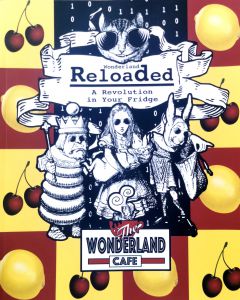
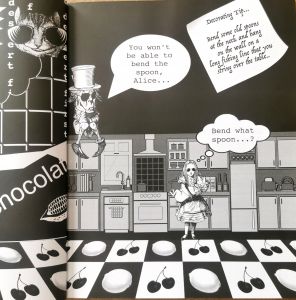
Zeer bizar boekje, met wel lekkere recepten en in de inleiding wordt geschreven:
“Near as I can tell, if you want to fit in, you can either cook the recipes I’ve gathered here. Or create some of your own based on the list above (steak, chicken, cookies, hard candy, cake, noodles, tasty wheat). What follows are my recommendations to field agents who want to infiltrate Wonderland before Alice and her ilk can do further damage to the frame.
Yours, Agent Smith
P.S. Many here believe she is “the One…” I’ll dispatch my best Jabberwocky to stop her”.
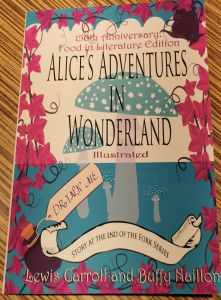
‘150th anniversary food in literature edition’ Alice’s Adventures in Wonderland. Auteurs Lewis Carroll en Buffy Naillon (wederom). De tekst van het compleet opgenomen verhaal wordt voorafgegaan door een korte biografie van Lewis Carroll, informatie over de betekenis van eten in de ‘Alice-boeken’ en de betekenis ervan in het Victoriaanse tijdperk. Uitgebreide bibliografie van de geraadpleegde literatuur.
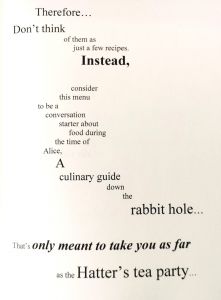
Als laatste nog een leuk Cocktailboek: Drink Me, Curious Cocktails from Wonderland.
“Nick Perry and Paul Rosser have delved into the depths of the Pool of Tears in search of the most magical flavors, and –after some sage advice from a helpful caterpillar—have compiled a list of recipes that would have been regularly enjoyed by the inhabitants of Wonderland.” Heel mooi vormgegeven boekje.
Enkele titels van hoofdstukken zijn: The Golden Afternoon, Off with Her Head, Mockturtletail en Cup of Mad Tea. Met quotes uit de Alice-boeken. Lekkere recepten van cocktails en ook van lekkere snacks die je erbij kunt serveren.
Om te proberen hierbij het recept voor Painting the Roses Red
Ingredients
1,5 oz (45 ml) Tanqueray London Gin
0,5 oz (15 ml) Briottet Creme de Framboise (raspberry) liqueur
1oz (30ml) raspberry and licorice syrup (zie foto hiernaast)
1 oz (30 ml) fresh squeezed lemon juice
4 drops rosewater
5 oz (150 ml) soda water
Red and white edible flowers
Method
- Pour the gin, raspberry liqueur, raspberry syrup, lemon juice and rosewater into a Boston glass over fresh cubed ice. Close the shaker and give it a long, hard shake.
- Fill a chilled highball glass with ice and strain the final mixture into the glass.
- Finally top the drink with soda water and garnish with red and white edible flowers.

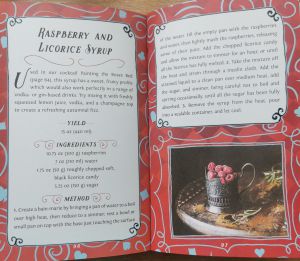
Wat ik hierboven heb beschreven is naar alle waarschijnlijkheid slechts een fractie van wat er is verschenen. Alice wordt ontelbaar vaak gebruikt en misbruikt, maar het levert af en toe wel hele smakelijke resultaten op. Ten slotte wil ik dan eindigen met een mooie tekst van Lewis Carroll zelf getiteld ‘Feeding the mind’, overigens ook in vertaling in het eerste genoemde boek opgenomen.
Breakfast, dinner, tea; in extreme cases, breakfast, luncheon, dinner, tea, supper, and a glass of something hot at bedtime. What care we take about feeding the lucky body! Which of us does as much for his mind? And what causes the difference? Is the body so much the more important of the two? By no means: but life depends on the body being fed, whereas we can continue to exist as animals (scarcely as men) though the mind be utterly starved and neglected. Therefore Nature provides that, in case of serious neglect of the body, such terrible consequences of discomfort and pain shall ensue, as will soon bring us back to a sense of our duty: and some of the functions necessary to life she does for us altogether, leaving us no choice in the matter. It would fare but ill with many of us if we were left to superintend our own digestion and circulation. . . . The consequences of neglecting the body can be clearly seen and felt; and it might be well for some if the mind were equally visible and tangible—if we could take it, say, to the doctor, and have its pulse felt.
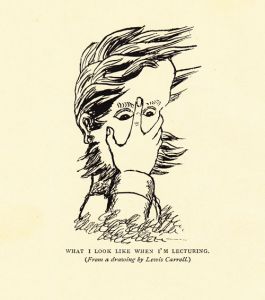
First, then, we should set ourselves to provide for our mind its proper kind of food. We very soon learn what will, and what will not, agree with the body, and find little difficulty in refusing a piece of the tempting pudding or pie which is associated in our memory with that terrible attack of indigestion, and whose very name irresistibly recalls rhubarb and magnesia; but it takes a great many lessons to convince us how indigestible some of our favourite lines of reading are, and again and again we make a meal of the unwholesome novel, sure to be followed by its usual train of low spirits, unwillingness to work, weariness of existence—in fact, by mental nightmare.
Then we should be careful to provide this wholesome food in proper amount. Mental gluttony, or over-reading, is a dangerous propensity, tending to weakness of digestive power, and in some cases to loss of appetite: we know that bread is a good and wholesome food, but who would like to try the experiment of eating two or three loaves at a sitting?
I have heard a physician telling his patient—whose complaint was merely gluttony and want of exercise—that ’the earliest symptom of hyper-nutrition is a deposition of adipose tissue,’ and no doubt the fine long words greatly consoled the poor man under his increasing load of fat.
I wonder if there is such a thing in nature as a FAT MIND? I really think I have met with one or two: minds which could not keep up with the slowest trot in conversation; could not jump over a logical fence, to save their lives; always got stuck fast in a narrow argument; and, in short, were fit for nothing but to waddle helplessly through the world.
Then, again, though the food be wholesome and in proper amount, we know that we must not consume too many kinds at once. Take the thirsty a quart of beer, or a quart of cider, or even a quart of cold tea, and he will probably thank you (though not so heartily in the last case!). But what think you his feelings would be if you offered him a tray containing a little mug of beer, a little mug of cider, another of cold tea, one of hot tea, one of coffee, one of cocoa, and corresponding vessels of milk, water, brandy-and-water, and butter-milk? The sum total might be a quart, but would it be the same thing to the haymaker?
Having settled the proper kind, amount, and variety of our mental food, it remains that we should be careful to allow proper intervals between meal and meal, and not swallow the food hastily without mastication, so that it may be thoroughly digested; both which rules, for the body, are also applicable at once to the mind.
First, as to the intervals: these are as really necessary as they are for the body, with this difference only, that while the body requires three or four hours’ rest before it is ready for another meal, the mind will in many cases do with three or four minutes. I believe that the interval required is much shorter than is generally supposed, and from personal experience, I would recommend anyone, who has to devote several hours together to one subject of thought, to try the effect of such a break, say once an hour, leaving off for five minutes only each time, but taking care to throw the mind absolutely ‘out of gear’ for those five minutes, and to turn it entirely to other subjects. It is astonishing what an amount of impetus and elasticity the mind recovers during those short periods of rest.
And then, as to the mastication of the food, the mental process answering to this is simply thinking over what we read. This is a very much greater exertion of mind than the mere passive taking in the contents of our Author. So much greater an exertion is it, that, as Coleridge says, the mind often ‘angrily refuses’ to put itself to such trouble—so much greater, that we are far too apt to neglect it altogether, and go on pouring in fresh food on the top of the undigested masses already lying there, till the unfortunate mind is fairly swamped under the flood. But the greater the exertion the more valuable, we may be sure, is the effect. One hour of steady thinking over a subject (a solitary walk is as good an opportunity for the process as any other) is worth two or three of reading only. And just consider another effect of this thorough digestion of the books we read; I mean the arranging and ’ticketing,’ so to speak, of the subjects in our minds, so that we can readily refer to them when we want them. Sam Slick tells us that he has learnt several languages in his life, but somehow ‘couldn’t keep the parcels sorted’ in his mind. And many a mind that hurries through book after book, without waiting to digest or arrange anything, gets into that sort of condition, and the unfortunate owner finds himself far from fit really to support the character all his friends give him.
‘A thoroughly well-read man. Just you try him in any subject, now. You can’t puzzle him.’
You turn to the thoroughly well-read man. You ask him a question, say, in English history (he is understood to have just finished reading ‘MaCauley). He smiles good-naturedly, tries to look as if he knew all about it, and proceeds to dive into his mind for the answer.
Up comes a handful of very promising facts, but on examination they turn out to belong to the wrong century, and are pitched in again. A second haul brings up a fact much more like the real thing, but, unfortunately, along with it comes a tangle of other things—a fact in political economy, a rule in arithmetic, the ages of his brother’s children, and a stanza of ‘Gray’ Elegy,’ and among all these, the fact he wants has got hopelessly twisted up and entangled. Meanwhile, every one is waiting for his reply, and, as the silence is getting more and more awkward, our well-read friend has to stammer out some half-answer at last, not nearly so clear or so satisfactory as an ordinary schoolboy would have given. And all this for want of making up his knowledge into proper bundles and ticketing them.
Do you know the unfortunate victim of ill-judged mental feeding when you see him? Can you doubt him? Look at him drearily wandering round a reading-room, tasting dish after dish—we beg his pardon, book after book—keeping to none. First a mouthful of novel; but no, faugh! he has had nothing but that to eat for the last week, and is quite tired of the taste. Then a slice of science; but you know at once what the result of that will be—ah, of course, much too tough for his teeth. And so on through the whole weary round, which he tried (and failed in) yesterday, and will probably try and fail in to-morrow.
Mr. Oliver Wendel Holmes, in his very amusing book, ‘The professor at the breakfast table,’ gives the following rule for knowing whether a human being is young or old: ‘The crucial experiment is this—offer a bulky bun to the suspected individual just ten minutes before dinner. If this is easily accepted and devoured, the fact of youth is established.’ He tells us that a human being, ‘if young, will eat anything at any hour of the day or night.’
To ascertain the healthiness of the mental appetite of a human animal, place in its hands a short, well-written, but not exciting treatise on some popular subject—a mental bun, in fact. If it is read with eager interest and perfect attention, and if the reader can answer questions on the subject afterwards, the mind is in first-rate working order. If it be politely laid down again, or perhaps lounged over for a few minutes, and then, ‘I can’t read this stupid book! Would you hand me the second volume of “The Mysterious Murder”?’ you may be equally sure that there is something wrong in the mental digestion.
If this paper has given you any useful hints on the important subject of reading, and made you see that it is one’s duty no less than one’s interest to ‘read, mark, learn, and inwardly digest’ the good books that fall in your way, its purpose will be fulfilled.
[print_button]



